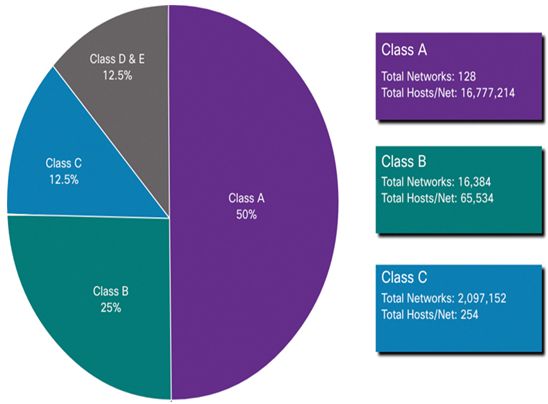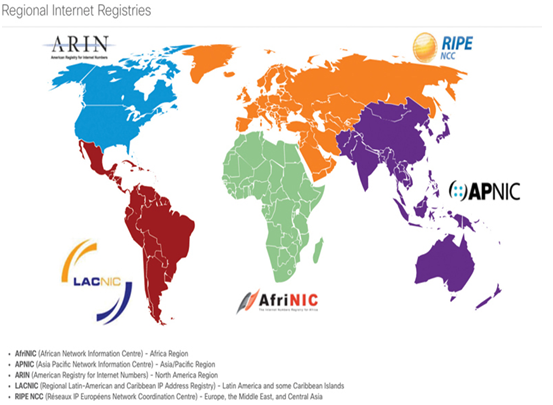In 1981, IPv4 addresses were assigned using classful addressing as defined in RFC 790 (https://tools.ietf.org/html/rfc790), Assigned Numbers. Customers were allocated a network address based on one of three classes, A, B, or C. The RFC divided the unicast ranges into specific classes as follows:
• Class A (0.0.0.0/8 to 127.0.0.0/8) — Designed to support extremely large networks with more than 16 million host addresses. Class A used a fixed /8 prefix with the first octet to indicate the network address and the remaining three octets for host addresses (more than 16 million host addresses per network).
• Class B (128.0.0.0 /16 – 191.255.0.0 /16) — Designed to support the needs of moderate to large size networks with up to approximately 65,000 host addresses. Class B used a fixed /16 prefix with the two high-order octets to indicate the network address and the remaining two octets for host addresses (more than 65,000 host addresses per network).
• Class C (192.0.0.0 /24 – 223.255.255.0 /24) — Designed to support small networks with a maximum of 254 hosts. Class C used a fixed /24 prefix with the first three octets to indicate the network and the remaining octet for the host addresses (only 254 host addresses per network).
Note
There is also a Class D multicast block consisting of 224.0.0.0 to 239.0.0.0 and a Class E experimental address block consisting of 240.0.0.0 – 255.0.0.0.
At the time, with a limited number of computers using the internet, classful addressing was an effective means to allocate addresses. As shown in Figure 9-5, Class A and B networks have a very large number of host addresses and Class C has very few. Class A networks accounted for 50% of the IPv4 networks. This caused most of the available IPv4 addresses to go unused.

Figure 9-5 Classful Addressing
In the mid-1990s, with the introduction of the World Wide Web (WWW), classful addressing was deprecated to more efficiently allocate the limited IPv4 address space. Classful address allocation was replaced with classless addressing, which is used today. Classless addressing ignores the rules of classes (A, B, C). Public IPv4 network addresses (network addresses and subnet masks) are allocated based on the number of addresses that can be justified.
Assignment of IP Addresses (9.2.6)
Public IPv4 addresses are addresses which are globally routed over the internet. Public IPv4 addresses must be unique.
Both IPv4 and IPv6 addresses are managed by the Internet Assigned Numbers Authority (IANA). The IANA manages and allocates blocks of IP addresses to the Regional Internet Registries (RIRs). The five RIRs are shown in Figure 9-6.
RIRs are responsible for allocating IP addresses to ISPs who provide IPv4 address blocks to organizations and smaller ISPs. Organizations can also get their addresses directly from an RIR (subject to the policies of that RIR).

Figure 9-6 Five Regional Internet Registries
The five RIRs shown if Figure 9-6 are as follows:
• AfriNIC (African Network Information Centre) – Africa Region
• APNIC (Asia Pacific Network Information Centre) – Asia/Pacific Region
• ARIN (American Registry for Internet Numbers) – North America Region
• LACNIC (Regional Latin-American and Caribbean IP Address Registry) – Latin America and some Caribbean Islands
• RIPE NCC (Réseaux IP Européens Network Coordination Centre) – Europe, the Middle East, and Central Asia
This section discusses network segmentation and the reasons why we want to divide larger networks into smaller networks known as subnets.
